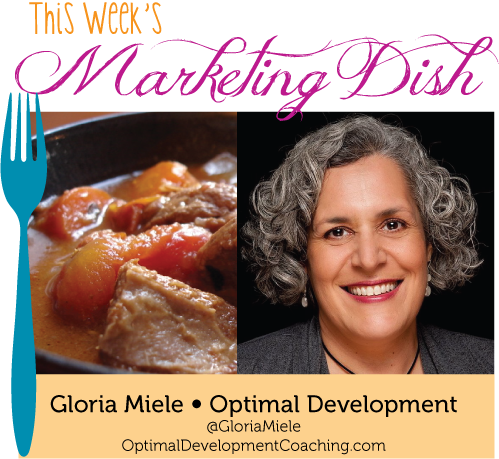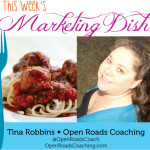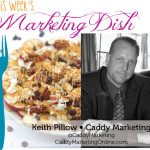Gloria Miele, a small biz coach from Camarillo, CA, emailed this week’s suggestion while she was cooking up a pot of beef stew over the holidays. Here’s what she had to say:
Most of the women in my family make stew this way (with some variation, like deglazing the pan with wine, peeling the potatoes, not using bay leaves), but I think the originator was my Grandma, an excellent Sicilian cook. My mother says it’s Italian because of the tomato sauce. It’s definitely great for fall and winter dinners. (See Gloria’s family recipe here.)
Gloria works with entrepreneurs to develop the tools, skills and support they need to achieve greater profitability and overall business success. She’s also a facilitator of Victory Circles, a comprehensive business development program for entrepreneurs. Visit her website to learn more.
This week’s Marketing Dish is about Substance
The other day I attended a webinar that promised to be more than just a sales pitch.
I heard, “Yes, there will be an offer presented at the end; but I want to give you something ‘meaty’ to take home and implement.”
Unfortunately, over the entire 1.5 hours I spent on that webinar, only 15 minutes of it was spent on delivering content — and that content was a little light on stuff we could actually do.
I found myself asking, “Where’s the Beef?”
If you’re as old as I am, you remember the Wendy’s commercial of the 80s that helped that restaurant chain stand out from the crowd. The question “Where’s the beef?” was asked by little old ladies and answered with substantive numbers like “our single patty has twice the beef of those at McDonalds or Burger King.”
In short, the Wendy’s burger had substance. It had heft. It satisfied.
If you’ve ever eaten beef stew, you know that if you don’t use enough actual beef in your recipe, you’re really eating a vegetable soup. The taste might be there, but the substance won’t be.
And substance isn’t just about the ingredients. It’s also about whether those ingredients have grown into their full potential. Cooking stew (or almost any soup) is also about taking your time. The longer you let your brew simmer, the better it will taste. In fact, if you save it and eat it the next day instead, you’ll find it’s really blossomed into something much more satisfying. The beef is more tender; the broth, thicker. It’s a process you just can’t rush.
In our businesses, we often scurry to get a new product launched without taking the necessary time to develop something of substance. Or, perhaps the product is fully formed, but our marketing around that product isn’t.
In the case of the webinar I attended yesterday, I think the latter is likely what happened. Knowing what I know about the person who gave it, I’m sure that the product is full of value and substance. Unfortunately, the marketing of that product fell a little flat because a promise was made that didn’t hit the mark.
The trick we all need to learn is how to find the right balance between enough and too much time in developing our marketing content. And since most of our marketing messages these days are wrapped up in other (free) content, we need to make sure that it’s meaty enough to satisfy our guests.
Here are two suggestions for making your content tasty and filling:
1. Don’t write content that only skims the surface of your topic. Take a stand. State your point of view. And then back it up with real examples. Seth Godin might be the king of short blog posts, but you’re not him. (And for that matter, neither am I.) It’s much better to write less frequently and make what you do write full of helpful and practical advice. I can’t write a good post without at least 900 words. And if I’m honest, I prefer more like 1200 to 1500 words to get my point across. What about you?
2. Don’t recycle what’s already out there. I can’t tell you how much content I see every day that’s simply rehashed from what the “experts” are saying. It’s called an “echo chamber” for a reason. One person (usually a guru of some sort) says something about a particular topic. That person’s audience nods their heads in agreement and proceeds to churn out similar-sounding advice for their own blogs and marketing channels. One way you can get around this pitfall is to ask questions.
Ask yourself, is this really true? Is there another perspective that hasn’t been explored? Are there other possible explanations for the conclusion that person came to?
Do some research before you publish something. Find out what other people have already said and take a different angle.
Or build on something that hasn’t yet been fully fleshed out.
What about you? Does your content marketing have substance? Are you taking enough time to create something that will really ‘hit the spot’ with your audience? If you’re feeling stuck on where to start and you’d like some help brainstorming, leave us a comment below and let’s see what we can do — together.











Thanks for turning my recipe into an important message for us all. With a webinar coming up next week, I’ll be extra cognizant of the substance we deliver.
I love this meaty post! I agree that, although the recipe sounded good, the webinar ended up tasting a little bland. It’s disappointing when recipes don’t turn out.
Really tasty marketing message, Tea! I’ve eaten several bowls of meatless (webinar/teleseminar/blog post/video/podcast) stew. Lots of carrots and celery … but little to no substance … and definitely not flavorful. I’ve wondered “Where’s the beef?” more times than I care to count. I’m especially unhappy when I’ve forked over some hard-earned dough for a bowl of hearty stew and get served a watered down version of some cheap tasteless soup.